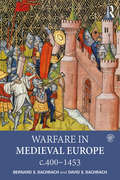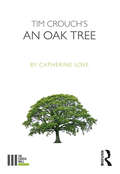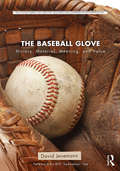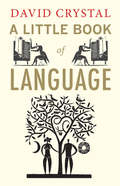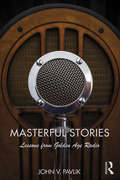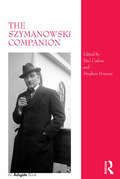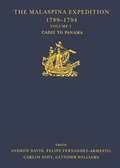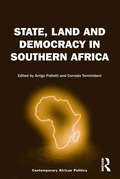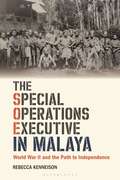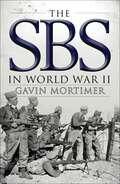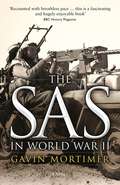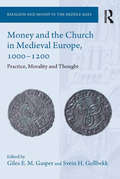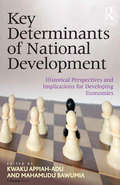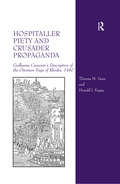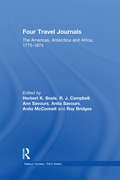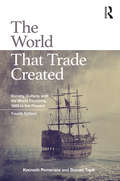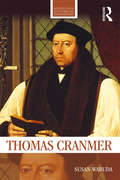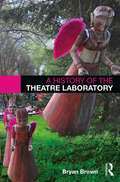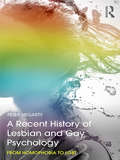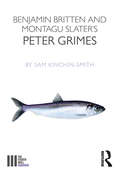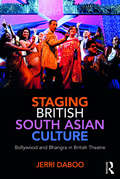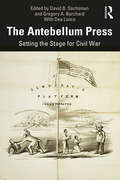- Table View
- List View
Warfare in Medieval Europe 400-1453
by Bernard S Bachrach David BachrachWarfare in Medieval Europe c. 400-c.1453 provides a thematic discussion of the nature and conduct of war, including its economic, technological, social, and religious contexts, from the late Roman Empire to the end of the Hundred Years’ War. The geographical scope of this volume encompasses Latin Europe from Iberia to Poland and from Scandinavia and Britain to Sicily and includes the interaction between Europe and the eastern Mediterranean, particularly in the context of the crusading movement. Bernard and David Bachrach explore the origins of the institutions, physical infrastructure, and intellectual underpinnings of medieval warfare and trace the ways in which medieval warfare was diffused beyond Europe to the Middle East and beyond. Written in an accessible and engaging way and including chapters on military topography, military technology, logistics, strategy and combat, this is a definitive synthesis on medieval warfare. The book is accompanied by a companion website which includes interactive maps of the chief military campaigns, chapter resources, a glossary of terms and an interactive timeline which provides a chronological backbone for the thematic chapters in the book. Warfare in Medieval Europe is an essential resource for all students of medieval war and warfare.
An Oak Tree
by Catherine LoveFirst Published in 2017. Routledge is an imprint of Taylor & Francis, an Informa company.
The Baseball Glove: History, Material, Meaning, and Value (Routledge Series for Creative Teaching and Learning in Anthropology)
by David JenemannThe baseball glove is a ubiquitous item, a crucial piece of equipment in the game of baseball, and it offers the opportunity to examine the production of material culture and social practice at numerous levels. Where and how is a glove made, and how does its manufacture square with the narratives surrounding its place in American cultural life? What are the myths, superstitions, and beliefs surrounding its acquisition, care, use, and significance? How does a glove function as the center of a web of cultural practices that illustrate how individuals relate to a consumer good as a symbol of memory, personal narrative, and national identity? How do the manufacturers of baseball gloves draw upon, promote, and in some sense create these practices? How do these practices and meanings change in other national and cultural contexts? The Baseball Glove offers students the opportunity to examine these questions in an engagingly written and illustrated book that promotes hands-on interaction with a quintessential item of material culture. At the same time, the book gives students the space for critical self-reflection about the place of material goods like sporting equipment in their lives, and it provides the chance to learn different methodological approaches to studying everyday objects.
A Little Book of Language (Little Histories)
by David CrystalWith a language disappearing every two weeks and neologisms springing up almost daily, an understanding of the origins and currency of language has never seemed more relevant. In this charming volume, a narrative history written explicitly for a young audience, expert linguist David Crystal proves why the story of language deserves retelling.From the first words of an infant to the peculiar modern dialect of text messaging, A Little Book of Language ranges widely, revealing language’s myriad intricacies and quirks. In animated fashion, Crystal sheds light on the development of unique linguistic styles, the origins of obscure accents, and the search for the first written word. He discusses the plight of endangered languages, as well as successful cases of linguistic revitalization. Much more than a history, Crystal’s work looks forward to the future of language, exploring the effect of technology on our day-to-day reading, writing, and speech. Through enlightening tables, diagrams, and quizzes, as well as Crystal’s avuncular and entertaining style, A Little Book of Language will reveal the story of language to be a captivating tale for all ages.
Masterful Stories: Lessons from Golden Age Radio
by John V PavlikThe early eras of radio storytelling have entered and continue to enter the public domain in large quantities, offering unprecedented access to the Golden Age of Radio. Author and Professor John Pavlik mines the best this age of radio has to offer in Masterful Stories, an examination of the masterpieces of audio storytelling. This book provides a chronological history of the best of the best from radio’s Golden Age, outlining a core set of principles and techniques that made these radio plays enduring examples of storytelling. It suggests that, by using these techniques, stories can engage audiences emotionally and intellectually. Grounded in a historical and theoretical understanding of radio drama, this volume illuminates the foundational works that proceeded popular modern shows such as Radiolab, The Moth, and Serial. Masterful Stories will be a powerful resource in both media history courses and courses teaching audio storytelling for modern radio and other audio formats, such as podcasting. It will appeal to audio fans looking to learn about and understand the early days of radio drama.
The Szymanowski Companion
by Stephen DownesThe Polish composer Karol Szymanowski is one of the most fascinating musical figures of the early twentieth century. His works included four symphonies, two violin concertos, the operas Hagith and King Roger, the ballet-pantomime Harnasie, the oratorio Stabat Mater, as well as numerous piano, violin, vocal and choral compositions. The profile and popularity of Szymanowski's music outside Poland has never been higher and continues to grow. The Szymanowski Companion constitutes the most significant and comprehensive reference source to the composer in English. Edited by two of the leading scholars in the field, Paul Cadrin and Stephen Downes, the collection consists of over 50 contributions from an international array of contributors, including recognized Polish experts. The Companion thus provides a systematic, authoritative and up-to-date compilation of information concerning the composer's life, thought and works.
The Malaspina Expedition 1789–1794: Journal of the Voyage by Alejandro Malaspina. Volume I: Cádiz to Panamá (Hakluyt Society, Third Series)
by Andrew David Felipe Fernández-Armesto Glyndwr WilliamsAmong the voyages of exploration and surveying in the late 18th century, that of Alejandro Malaspina best represents the high ideals and scientific interests of the Enlightenment. Italian-born, Malaspina entered the Spanish navy in 1774. In September 1788 he and fellow-officer José Bustamante submitted a plan to the Ministry of Marine for a voyage of survey and inspection to Spanish territories in the Americas and Philippines. The expedition was to produce hydrographic charts for the use of Spanish merchantmen and warships and to report on the political, economic and defensive state of Spain's overseas possessions. The plan was approved and in July 1789 Malaspina and Bustamante sailed from Cádiz in the purpose-built corvettes, Descubierta and Atrevida. On board the vessels were scientists and artists and an array of the latest surveying and astronomical instruments. The voyage lasted more than five years. On his return Malaspina was promoted Brigadier de la Real Armada, and began work on an account of the voyage in seven volumes to dwarf the narratives of his predecessors in the Pacific such as Cook and Bougainville. Among much else, it would contain sweeping recommendations for reform in the governance of Spain's overseas empire. But Malaspina became involved in political intrigue. In November 1795 he was arrested, stripped of his rank and sentenced to life imprisonment. Although released in 1803, Malaspina spent the last seven years of his life in obscure retirement in Italy. He never resumed work on the great edition, and his journal was not published in Spain until 1885. Only in recent years has a multi-volume edition appeared under the auspices of the Museo Naval, Madrid, that does justice to the achievements of what for long was a forgotten voyage. This first volume of a series of three contains Malaspina's diario or journal from 31 July 1789 to 14 December 1790, newly translated into English, with substantial introduction and commentary. Among the places visited and described are Montevideo, Puerto Deseado, Port Egmont, Puerto San Carlos, ValparaÃso, Callao, Guayaquil and Panamá. Other texts include Malaspina's introduction to his intended edition, and his correspondence with the Minister of the Marine before and during the voyage.
State, Land and Democracy in Southern Africa (Contemporary African Politics)
by Arrigo Pallotti Corrado TornimbeniEach country in southern Africa has a unique history but in all of them socio-economic inequalities and high poverty levels weaken the governments’ legitimacy and represent a challenge to models of economic development. One key issue appears to be the solution of the land question. This vital concern affects both citizenship and democracy in the political systems of the region, yet no government has shown the capacity or commitment to solve it. In this volume leading European, American and African scholars explore in detail the relationship between state, land and democracy. They examine the historical background of asset allocation and its impact on questions of nationality, the definition of citizenship, human rights and the current political and economic processes in southern Africa.
The Special Operations Executive in Malaya: World War II and the Path to Independence
by Rebecca KenneisonDuring World War II, agents of the Special Operations Executive (SOE) infiltrated Japanese-occupied Malaya. There they worked with Malayan guerrilla groups, including the communist-sponsored Malayan Peoples Anti-Japanese Army (MPAJA), regarded as the precursor of the communist insurgent army of the Malayan Emergency. This book traces the development of SOE's Malayan operations, and analyses the interactions between SOE and the various guerrilla groups. It explores the reasons for and the extent of Malay disillusionment with Japanese rule, and demonstrates how guerrilla service acted as a training ground for some later Malay leaders of the independent nation. However, the reports written about the MPAJA by SOE operatives just after the war failed to draw out the likely future threat posed by the communists to the returning colonial administration. Rebecca Kenneison shows that the British possessed a wealth of local information, but failed to convert it into active intelligence in the period prior to the Malayan Emergency. In doing so she provides new insights into the impact of SOE on Malayan politics, the nature of Malayan communism's challenge to colonial rule, and British post-war intelligence in Malaya.
The Special Operations Executive in Malaya: World War II and the Path to Independence
by Rebecca KenneisonDuring World War II, agents of the Special Operations Executive (SOE) infiltrated Japanese-occupied Malaya. There they worked with Malayan guerrilla groups, including the communist-sponsored Malayan Peoples Anti-Japanese Army (MPAJA), regarded as the precursor of the communist insurgent army of the Malayan Emergency. This book traces the development of SOE's Malayan operations, and analyses the interactions between SOE and the various guerrilla groups. It explores the reasons for and the extent of Malay disillusionment with Japanese rule, and demonstrates how guerrilla service acted as a training ground for some later Malay leaders of the independent nation. However, the reports written about the MPAJA by SOE operatives just after the war failed to draw out the likely future threat posed by the communists to the returning colonial administration. Rebecca Kenneison shows that the British possessed a wealth of local information, but failed to convert it into active intelligence in the period prior to the Malayan Emergency. In doing so she provides new insights into the impact of SOE on Malayan politics, the nature of Malayan communism's challenge to colonial rule, and British post-war intelligence in Malaya.
The SBS in World War II: An Illustrated History (General Military Ser.)
by Gavin MortimerThe Special Boat Squadron was Britain's most exclusive Special Forces unit during World War II. Highly trained, totally secretive and utterly ruthless, the SBS was established as an entity in its own right in early 1943, having previously operated under the auspices of the SAS during the war in North Africa. Unlike its sister unit, which numbered more than 1,000 men, the SBS never comprised more than 100. Led by men such as the famed Victoria Cross recipient Anders Lassen, the SBS went from island to island in the Mediterranean, landing in the dead of night in small fishing boats and launching savage hit and run raids on the Germans. By the end of the war they had served in Italy, the Balkans and mainland Greece, and following the cessation of hostilities their deeds were airbrushed out of history by an establishment that had never warmed to their piratical exploits. Through unrivalled access to the SBS archives and interviews with the surviving members of the unit, Gavin Mortimer has pieced together the dramatic exploits of this elite fighting force, fully illustrated with images of their daring actions, finally granting the unit the recognition they so richly deserved.
The SAS in World War II (General Military Ser.)
by Gavin MortimerThe SAS are among the best-trained and most effective Special Forces units in existence. This book is the incredible story of their origins, told in their own words. During the summer of 1941, a young Scots Guard officer called David Stirling persuaded MEHQ to give its backing to a small band of 60 men christened 'L Detachment'. With a wealth of stunning photographs, many from the SAS Regimental Archives, the book captures the danger and excitement of the initial SAS raids against Axis airfields during the Desert War, the battles in Italy and those following the D-Day landings, as well as the dramatic final push into Germany itself and the discovery of such Nazi horrors as Belsen. An exhaustive account of an elite organization's formative years, The SAS in World War II is the fruit of Gavin Mortimer's expertise and his unprecedented access to the SAS Regimental Archives. Incorporating interviews with the surviving veterans, it is the definitive account of the regiment's glorious achievements in the years from 1941 to 1945.
Money and the Church in Medieval Europe, 1000-1200: Practice, Morality and Thought (Religion and Money in the Middle Ages)
by Giles E. Gasper Svein H. GullbekkBringing together essays from experts in a variety of disciplines, this collection explores two of the most important facets of life within the medieval Europe: money and the church. By focusing on the interactions between these subjects, the volume addresses four key themes. Firstly it offers new perspectives on the role of churchmen in providing conceptual frameworks, from outright condemnation, to sophisticated economic theory, for the use and purpose of money within medieval society. Secondly it discusses the dichotomy of money for the church and its officers: on one hand voices emphasise the moral difficulties in engaging with money, on the other the reality of the ubiquitous use of money in the church at all levels and in places within Christendom. Thirdly it places in dialogue interdisciplinary perspectives and approaches, and evidence from philosophy, history, literature and material culture, to the issues of money and church. Lastly, the volume provides new perspectives on the role of the church in the process of monetization in the High Middle Ages. Concentrating on northern Europe, from the early eleventh century to the beginning of the thirteenth century, the collection is able to explore the profound changes in the use of money and the rise of a money-economy that this period and region witnessed. By adopting a multi-disciplinary approach, the collection challenges current understanding of how money was perceived, understood and used by medieval clergy in a range of different contexts. It furthermore provides wide-ranging contributions to the broader economic and ethical issues of the period, demonstrating how the church became a major force in the process of monetization.
Key Determinants of National Development: Historical Perspectives and Implications for Developing Economies
by Kwaku Appiah-Adu Mahamudu BawumiaFor those wishing to acquire knowledge on national development issues, this comprehensive compendium traverses a spectrum of subjects that the audience ought to be well acquainted with. The Editors provide instructive findings regarding national development, economic growth and their determinants, but they also offer historical perspectives on the subject and the implications for developing countries. The book addresses a suite of critical themes regarded by development experts to be germane in considering the pertinence of policies and their effective execution. These seven general thematic areas are explored: ¢ Leadership, governance, policy and strategy ¢ Public sector and public financial management ¢ Culture, institutions and people ¢ Natural resources ¢ Science, technology and infrastructure ¢ Private sector and financial markets ¢ Marketing, branding and service delivery This thematic approach enables the contributors to explore the impact of the constituents of each subject area on national development, within the context of a developing economy. The significance of the findings for the relevant stakeholders is consequently reviewed. The combination of theory and practice makes the book and its contents unique.
Hospitaller Piety and Crusader Propaganda: Guillaume Caoursin's Description of the Ottoman Siege of Rhodes, 1480
by Theresa M. Vann Donald J. KagayGuillaume Caoursin, the Vice-chancellor of the Order of the Hospital, wrote the Obsidionis Rhodiae urbis descriptio (Description of the Siege of Rhodes) as the official record of the Ottoman siege of the Knights in Rhodes in 1480. The Descriptio was the first authorized account of the Order’s activities to appear in printed form, and it became one of the best sellers of the 15th century. The publication of the Descriptio not only fed Western Europe’s hunger for news about an important Christian victory in the ongoing war with the Turks, it also served to shape public perceptions of the Hospitallers. Caoursin wrote in a humanistic style, sacrificing military terminology to appeal to an educated audience; within a few years, however, his Latin text became the basis for vernacular versions, which also circulated widely. Modern historians recognize the contributions that the Ottoman siege of Rhodes in 1480 made in the development of military technology, particularly the science of fortifications. This book is the first complete modern Latin edition with an English translation of the Descriptio obsidionis Rhodiae. Two other published eyewitness accounts, Pierre D’Aubusson’s Relatio obsidionis Rhodie and Jacomo Curte’s De urbis Rhodiae obsidione a. 1480 a Turcis tentata, also appear in modern Latin edition and English translation. This book also includes John Kay’s Description of the Siege of Rhodes and an English translation of Ademar Dupuis’ Le siège de Rhodes. The lengthy introductory chapters by Theresa Vann place the Ottoman siege of Rhodes in 1480 within the context of Mehmed II’s expansion in the Eastern Mediterranean after he captured Constantinople in 1453. They then examine the development of an official message, or propaganda, as an essential tool for the Hospitallers to raise money in Europe to defend Rhodes, a process that is traced through the chancery’s official communications describing the aftermath of Constantinople and the Ottoman
Four Travel Journals / The Americas, Antarctica and Africa / 1775-1874 (Hakluyt Society, Third Series)
by R. J. Campbell Herbert K. Beals Ann Savours Anita McConnell Roy BridgesThis volume offers annotated texts with biographical and historical introductions of four previously unpublished travel journals from the period 1775-1874. The first of these is the journal of a participant in a Spanish expedition sent from Mexico to explore the north-west coast of America. From the outset, difficulties plagued the voyage. Bodega's ship, a small schooner named Sonora, was not designed for open-ocean voyaging. A landing party was attacked and killed; midway into the voyage the Sonora became separated from her flagship; and later she was nearly capsized by a massive wave. Bodega's journal records the voyage's travails, hardships, discoveries, and eventual return. Next comes the journal of Commander Stokes, who served in command of HMS Beagle, under Captain P. P. King during the survey of the Straits of Magellan in 1827. This is an account of a detached operation, in very difficult weather conditions, in the western part of the strait. It is introduced by remarks on the expedition and the hydrographic history of the strait from its discovery to the inception of the survey and supplemented by remarks from Captain King's account and also that of the clerk, Macdouall. The third text is the journal of a young midshipman in HMS Chanticleer, a small vessel commanded by Henry Foster, RN, who had recently been elected a Fellow of the Royal Society for his scientific work in the Arctic. The voyage of 1828-31 was to make observations in the South Atlantic to determine the shape of the Earth and to ascertain the longitudes of a number of ports. Kay's lively diary describes the Chanticleer's encounters with warships of the Brazilian navy, largely manned by Englishmen. He records his struggle to take observations at Deception Island during gales and snowstorms, and near Cape Horn in fierce squalls and constant chilling rain, nevertheless remaining cheerful in the company of his fellow midshipmen. The final piece is the diary of Jacob Wainwright.
The World That Trade Created: Society, Culture, and the World Economy, 1400 to the Present (Sources And Studies In World History Ser.)
by Kenneth Pomeranz Steven TopikThe World That Trade Created brings to life the history of trade and its actors. In a series of brief, highly readable vignettes, filled with insights and amazing facts about things we tend to take for granted, the authors uncover the deep historical roots of economic globalization. Covering over seven hundred years of history, this book, now in its fourth edition, takes the reader around the world from the history of the opium trade to pirates, to the building of corporations and migration to the New World. The chapters are grouped thematically, each featuring an introductory essay designed to synthesize and elaborate on key themes, both familiar and unfamiliar. It includes ten new essays, on topics ranging from the early modern ivory and slave trades across the Indian Ocean, to the ways in which the availability of new consumer goods helped change work habits in both Europe and East Asia, and from the history of chewing gum to that of rare earth metals. The introductory essays for each chapter, the overall introduction and epilogue, and several of the essays have also been revised and updated. The World That Trade Created continues to be a key resource for anyone teaching world history, world civilization, and the history of international trade.
Thomas Cranmer (Routledge Historical Biographies)
by Susan WabudaThomas Cranmer’s place in English history is firmly established, yet the complexities of his character have remained obscure and he continues to be one of the most problematic figures of the Tudor period. Susan Wabuda’s biography sheds fresh light not only on the private Cranmer, but also on the qualities that enabled him to master a shifting political landscape and to build a new English Church. Athletic by nature, Cranmer enjoyed hunting and he was a keen collector of books. He was blessed with several lifelong friendships and twice risked his career by marrying the women he loved. A skilled debater and a deft politician, Cranmer sought to balance his long-term plans for the Church against the immediate demands of survival at court. Obedient at all times, yet never entirely trustworthy, he had to reconcile the will of his God with the will of the monarch he served. For too long, Cranmer’s legacy has overshadowed the life of the man himself, but this new biography enriches and extends our understanding of both. Accessible and informative, it will be essential reading for students and scholars of the English Reformation and the Tudor age.
A History of the Theatre Laboratory
by Bryan BrownThe term ‘theatre laboratory’ has entered the regular lexicon of theatre artists, producers, scholars and critics alike, yet use of the term is far from unified, often operating as an catch-all for a web of intertwining practices, territories, pedagogies and ideologies. Russian theatre, however, has seen a clear emergence of laboratory practice that can be divided into two distinct organisational structures: the studio and the masterskaya (artisanal guild). By assessing these structures, Bryan Brown offers two archetypes of group organisation that can be applied across the arts and sciences, and reveals a complex history of the laboratory’s characteristics and functions that support the term’s use in theatre. This book’s discursive, historical approach has been informed substantially by contemporary practice, through interviews with and examinations of practitioners including Slava Polunin, Anatoli Vassiliev, Sergei Zhenovach and Dmitry Krymov.
A Recent History of Lesbian and Gay Psychology: From Homophobia to LGBT
by Peter HegartyThis ground-breaking text explores the contemporary history of how psychological research, practice, and theory has engaged with gay and lesbian movements in the United States and beyond, over the last 50 years. Peter Hegarty examines the main strands of research in lesbian and gay psychology that have emerged since the de-pathologizing of homosexuality in the 1970s that followed from the recognition of homophobia and societal prejudice. The author details the expansion of ‘lesbian and gay psychology’ to ‘LGB’ to ‘LGBT psychology’ via its paradigm shifts, legal activism, shifts in policy makers’ and mental health professionals’ goals in regard to sexual and gender minorities. For the first time, the origins of the concepts, debates, and major research programs that have made up the field of LGBT psychology have been drawn together in a single historical narrative, making this a unique resource. A case is made that psychology has only very lately come to consider the needs and issues of transgender and intersex people, and that LGB paradigms need to be critically interrogated to understand how they can be best brokered to bring about social change for such groups. A Recent History of Lesbian and Gay Psychology will serve as an advanced historical introduction to this field’s recent history and current concerns, and will inform both those who have been a part of this history and students who are new to the field.
Peter Grimes (The\fourth Wall Ser.)
by Sam Kinchin-Smithã `Who can turn skies back and begin again?' -Peter ã This book contends that Peter Grimes, widely regarded as one of the greatest and most influential operas of the 20th century, is also one of the British theatre's finest `lost' plays. Seeking to liberate Britten and Slater's work from the blinkered traditions of theatre and opera criticism, Sam Kinchin-Smith poses two questions: If an opera was created like a play, and can be staged as a play, is it a play? If a portion of its success and influence is the product of this newly identified theatrical engine, is it then a great play? The answers involve Wagner and W.G. Sebald, George Crabbe and Complicite, Akenfield and Twin Peaks. Challenging long-established narratives of post-war theatre history, this book makes a compelling case for why practitioners and scholars of performance ought to pay more attention to Britten and Slater's achievement - a milestone of unconventional English modernism - and perhaps to other operatic masterpieces too.
Staging British South Asian Culture: Bollywood and Bhangra in British Theatre
by Jerri DabooStaging British South Asian Culture: Bollywood and Bhangra in British Theatre looks afresh at the popularity of forms and aesthetics from Bollywood films and bhangra music and dance on the British stage. From Andrew Lloyd Webber’s Bombay Dreams to the finals of Britain’s Got Talent, Jerri Daboo reconsiders the centrality of Bollywood and bhangra to theatre made for or about British South Asian communities. Addressing rarely discussed theatre companies such as Rifco, and phenomena such as the emergence of large- scale Bollywood revue performances, this volume goes some way towards remedying the lack of critical discourse around British South Asian theatre. A timely contribution to this growing field, Staging British South Asian Culture is essential reading for any scholar or student interested in exploring the highly contested questions of identity and representation for British South Asian communities.
The Antebellum Press: Setting the Stage for Civil War
by David B. Sachsman Gregory A. BorchardThe Antebellum Press: Setting the Stage for Civil War reveals the critical role of journalism in the years leading up to America’s deadliest conflict by exploring the events that foreshadowed and, in some ways, contributed directly to the outbreak of war. This collection of scholarly essays traces how the national press influenced and shaped America’s path towards warfare. Major challenges faced by American newspapers prior to secession and war are explored, including: the economic development of the press; technology and its influence on the press; major editors and reporters (North and South) and the role of partisanship; and the central debate over slavery in the future of an expanding nation. A clear narrative of institutional, political, and cultural tensions between 1820 and 1861 is presented through the contributors’ use of primary sources. In this way, the reader is offered contemporary perspectives that provide unique insights into which local or national issues were pivotal to the writers whose words informed and influenced the people of the time. As a scholarly work written by educators, this volume is an essential text for both upper-level undergraduates and postgraduates who study the American Civil War, journalism, print and media culture, and mass communication history.
The Antebellum Press: Setting the Stage for Civil War
by David B. Sachsman Gregory A. BorchardThe Antebellum Press: Setting the Stage for Civil War reveals the critical role of journalism in the years leading up to America’s deadliest conflict by exploring the events that foreshadowed and, in some ways, contributed directly to the outbreak of war. This collection of scholarly essays traces how the national press influenced and shaped America’s path towards warfare. Major challenges faced by American newspapers prior to secession and war are explored, including: the economic development of the press; technology and its influence on the press; major editors and reporters (North and South) and the role of partisanship; and the central debate over slavery in the future of an expanding nation. A clear narrative of institutional, political, and cultural tensions between 1820 and 1861 is presented through the contributors’ use of primary sources. In this way, the reader is offered contemporary perspectives that provide unique insights into which local or national issues were pivotal to the writers whose words informed and influenced the people of the time. As a scholarly work written by educators, this volume is an essential text for both upper-level undergraduates and postgraduates who study the American Civil War, journalism, print and media culture, and mass communication history.
Architecture of Defeat
by Kengo KumaKengo Kuma, one of Japan’s leading architects, has been combining professional practice and academia for most of his career. In addition to creating many internationally recognized buildings all over the world, he has written extensively about the history and theory of architecture. Like his built work, his writings also reflect his profound personal philosophy. Architecture of Defeat is no exception. Now available in English for the first time, the book explores events and architectural trends in the twentieth and twenty-first centuries in both Japan and beyond. It brings together a collection of essays which Kuma wrote after disasters such as the destruction of the World Trade Center in New York City on 9/11 and the earthquake and tsunami that obliterated much of the built landscape on Japan’s northern shore in a matter of minutes in 2011. Asking if we have been building in a manner that is too self-confident or arrogant, he examines architecture’s intrinsic—and often problematic—relationship to the powerful forces of contemporary politics, economics, consumerism, and technology, as well as its vital ties to society. Despite the title, Architecture of Defeat is an optimistic and hopeful book. Rather than anticipating the demise of architecture, Kuma envisages a different mode of conceiving architecture: guided and shaped by more modesty and with greater respect for the forces of our natural world. Beautifully designed and illustrated, this is a fascinating insight into the thinking of one of the world’s most influential architects.
